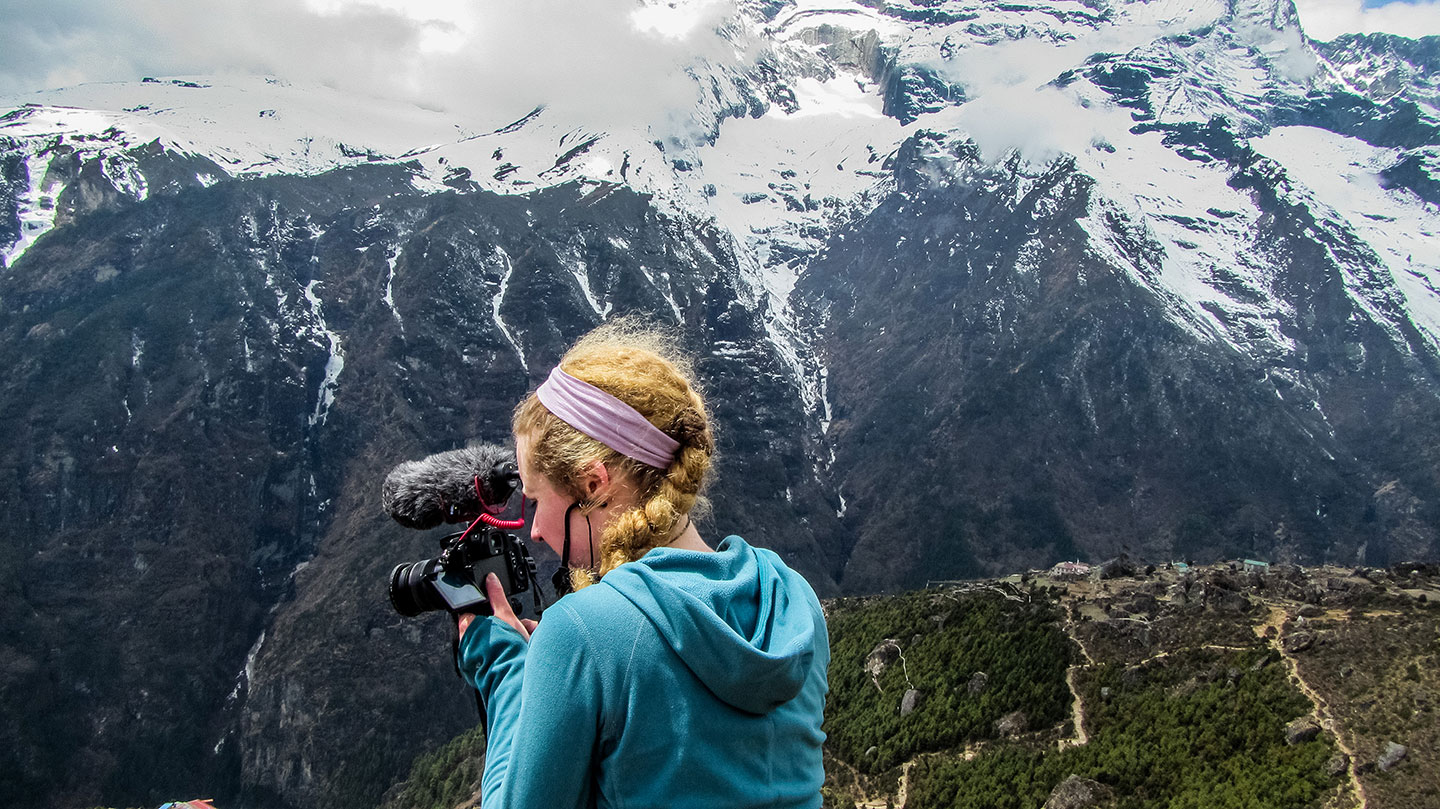Moving Mountains
By Laura Griffin
When recent Montclair State film graduates Meredith Gaito ’15, Sierra Johansen ’14 and Mike Pacyna ’14 set out to make a documentary about a climber with cystic fibrosis tackling Mount Everest, they thought about what could go wrong and devised several back-up plans.
But they never counted on this.
Sierra Johansen ’14 shoots footage in Namche on the way to Mount Everest. Photos from Mount Everest by Sierra Johansen and Mike Pacyna
For what seemed like days, Meredith Gaito held her breath.
Fear and anxiety built as the fledgling film producer waited in New Jersey for news of the fate of her friends and fellow filmmakers, Sierra Johansen and Mike Pacyna on Mount Everest. While she watched the events of April 25, 2015, unfold on CNN, the death toll was mounting in the massive earthquake that struck Nepal and set off an avalanche on Mount Everest. By final count, nearly 9,000 people had been killed, including 19 people on the mountain – one with the group that Johansen and Pacyna were there to film.
“I sent them there – on this amazing project and adventure. I was so scared something bad might have happened to them,” recalls Gaito.
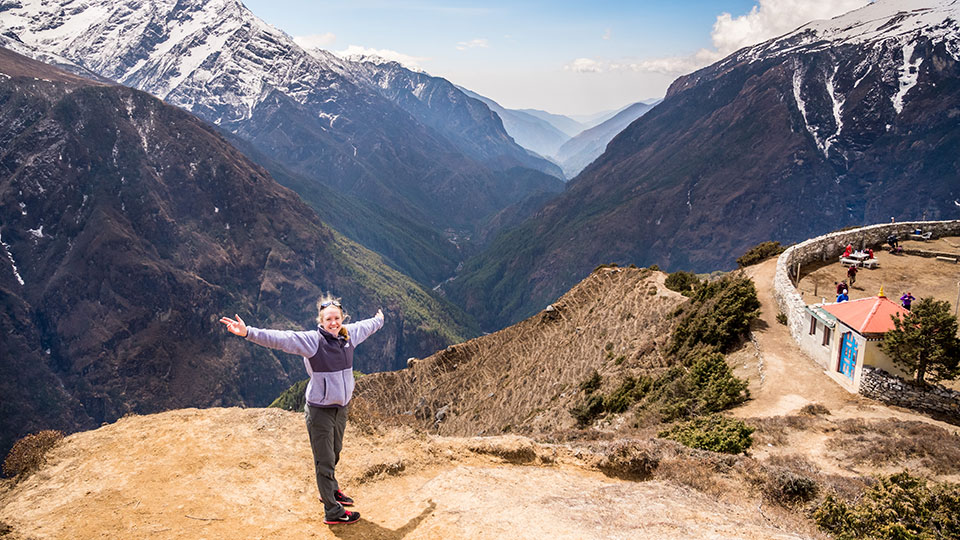
Sierra Johansen in the Himalayas before the earthquake struck.
Breathing on Everest
More than a year earlier, Gaito, who suffers from cystic fibrosis (CF) herself, had come across Nick Talbot’s plan to climb Mount Everest on the Internet while she was still a student at Montclair State and was procrastinating during finals in May of 2014. Knowing how hard it can be for those with CF to breathe under normal conditions sometimes, she was amazed that Talbot was attempting to climb the world’s highest peak. And since she knows firsthand what it’s like to live with the disease, she thought she was the perfect person to tell his story.
Talbot thought so, too. She reached out to him on Facebook and to her surprise, he welcomed the opportunity to document the climb to raise awareness and to aid in his efforts to raise money for research. “I wanted to do this documentary because I feel that it will help raise the profile for CF,” Talbot says.
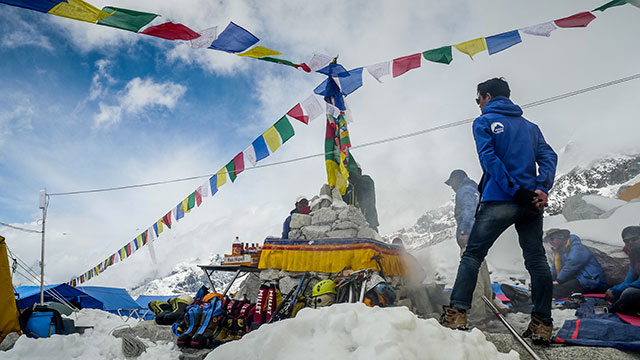
A Sherpa watches a ceremony at base camp.
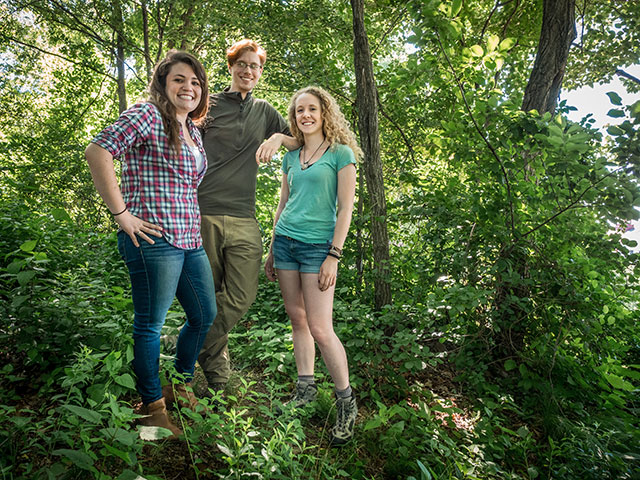
Director Meredith Gaito with Pacyna and Johansen upon their return to New Jersey. Photo by Mike Peters
And so began Breathing on Everest. Gaito started planning the documentary before her January 2015 graduation, enlisting her friends and fellow film students to sign on with her production company.
“I told them, I can’t afford to pay you, but I can promise you an adventure,” she recalls. “They were fine with that.”
Originally, Gaito planned to join Johansen in Nepal, so they trained for months – hiking and climbing mountains in the Northeast. But as the training got harder, she realized that her cystic fibrosis would be unmanageable on Mount Everest. When she got a lung infection that required intravenous antibiotics, she knew Pacyna would need to replace her on the trip.
“I sent them there – on this amazing project and adventure. I was so scared something bad might have happened to them.”
–Meredith Gaito
While the 40-year-old Talbot trained and made plans for the climb with Jagged Globe Expeditions, scheduled for April 2015, the 23-year-old filmmakers went about planning the film and searching for funding for the documentary.
The recent grads came back to Montclair State several times to consult with professors who’d helped them along the way.
“Meredith would come and plan and map out a story line,” said Susan Skoog, an adjunct professor who’d taught Gaito a few times but never knew she had cystic fibrosis. “It was a cool story and exciting for them, especially when they got funding and it was really happening.”
Funding, in the way of a $30,000 grant, arrived from the Cystic Fibrosis Trust in the United Kingdom, just days before the trip to Nepal, much to the relief of the first-time filmmakers.
“We got the green light and the money five days before they left,” Meredith said. “I was freaking out because I have a crew ready to fly out and we had no equipment. We almost pulled the plug a couple of times, but decided to wait it out.”
So with their $10,000 worth of new equipment and trekking gear, Johansen and Pacyna were ready to take on the documentary and the mountain.
Inside a cloud of snow
On the morning of April 25, two weeks into their trip, the sky was blue and Johansen and Pacyna were halfway through their hour-long hike to the Mount Everest base camp for a day of filming when the ground began moving. “It was shaking so hard, I had to try to stay standing up. I was in a spot where on one side there were rocks and a cliff and the other side were rocks and a mountain,” Pacyna recalls. “Rocks started rolling downhill, and I thought I better get away from the rocks, but there were rocks everywhere.”
There was a loud roar and a cloud of snow billowed ahead and they could no longer see the mountain or anything else but the white cloud.
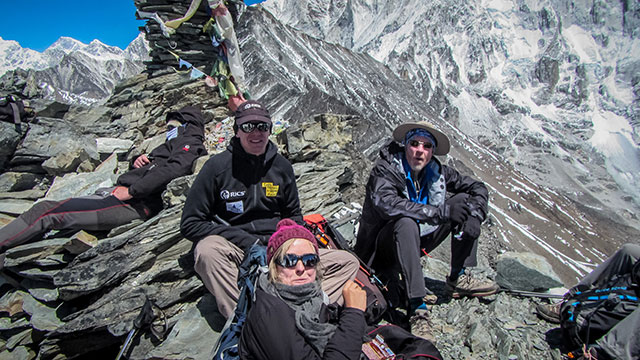
Climber Nick Talbot (in cap) and others take a rest.
“We knew it was an avalanche but we weren’t too worried at that point because avalanches never reached base camp, so it didn’t occur to us that it could be destroyed,” remembers Johansen, who was lower on the mountain than Pacyna. “It wasn’t until we got close to base camp that we started seeing the damage and we started freaking out. We’d become friends with the climbers and they, along with all of our equipment, were at base camp.”
When they arrived at base camp, tents were covered in snow or destroyed; people were searching for the missing and tending to the injured. It looked nothing like it had two days earlier, the last time they were there.
“It looked like a bomb had gone off. But the Himalayan Rescue Association tent was still there so we were able to get our bearings and figure out where our team was,” Johansen said. “Nick was injured and suffering from hypothermia – his legs had been covered in ice. They were trying to warm him up. And then we learned that a member of our team – Dan Fredinburg, this man who was a Google engineer who had this big personality and so full of life – had died. It was so sad.”
They lost some of their equipment in the avalanche but a camera was still working and they began filming the destruction and were able to interview Nick before he was airlifted out.
“We were in shock ourselves,” Johansen said. “We didn’t want to do too much filming at base camp – it felt disrespectful, after losing Dan. But we knew we had to get some footage and we needed to interview Nick.”
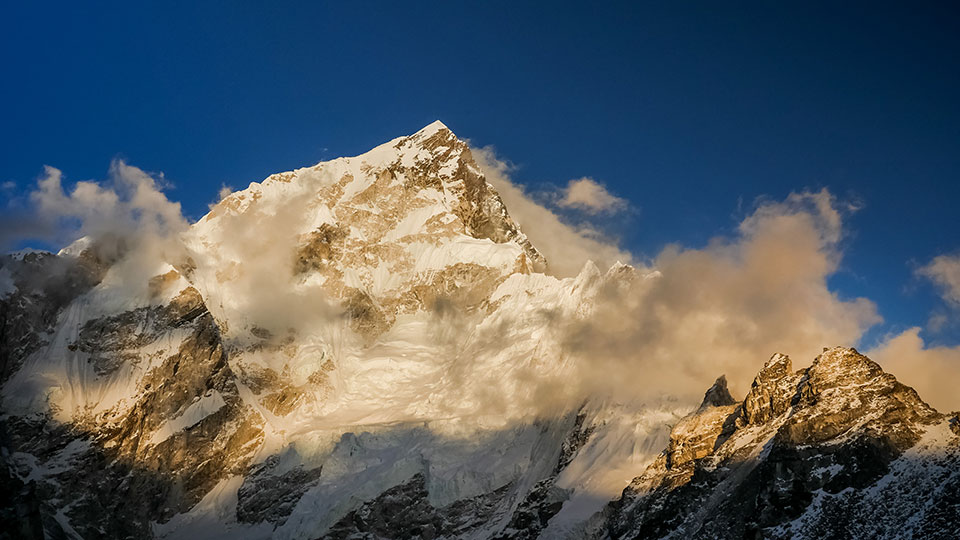
A sunset view from base camp.
The Story Will Tell Itself
After the interview, they decided to leave base camp, where they felt they were in the way of rescue efforts and they started the long trek back – first to their lodge below base camp and then to a village that was a three-day hike away, through destroyed villages, rocky mountain passes and rickety suspension bridges. When they got there, they spent a couple of days in line for seats on a small propeller plane to Kathmandu.
As they left the mountain and ventured further into Nepal, it became clear just how devastated the country was. Older buildings were reduced to rubble and people were afraid to sleep indoors. One bustling village they had passed through when they first arrived, now “looked like a ghost town.”
“It was really sad to see all that culture obliterated,” Johansen says. “We got a hotel in Kathmandu, but we still stayed in tents outside on the grounds because it wasn’t safe. It was surreal.”
It was a couple of days after the earthquake before they were able to call home.
For Gaito, the waiting was excruciating and, again, she turned to her former professors for guidance.
“Of course, it wasn’t her fault, but she felt responsible that she’d put them in harm’s way,” Skoog, her former film professor, recalls. “It’s a lot for a young person to deal with. When we knew they were all right, I told her to tell them to keep shooting. You never know where the story is going to lead you. The story will tell itself.”
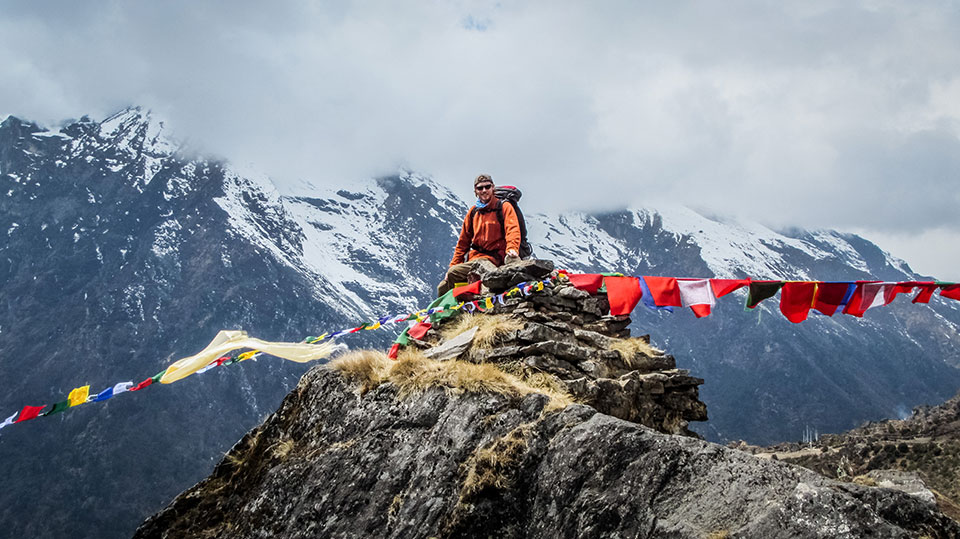
Mike Pacyna in Namache on the way to Mount Everest base camp.
Like a Dream
When they finally got out of Nepal and returned to day-to-day life in New Jersey, it felt even more surreal.
“It’s weird to come back to civilization after being where everything is devastated,” Pacyna said. “It’s weird that everything is so normal. I’ll hear the avalanche sound in my head and realize it’s a plane in the distance.”
Since the earthquake, the filmmakers have been to London to visit Talbot, the climber, who has made a full recovery and is determined to attempt to conquer Mount Everest again.
So the story continues. And the filmmakers are up for wherever it takes them.
They’ve started a Go Fund Me page to help with project expenses, and will donate 5 percent of the proceeds to cystic fibrosis research and 5 percent to Nepal earthquake relief. There will be more time to train this time. As Gaito sees it, the film currently has three plot lines – Talbot’s story, Johansen and Pacyna’s story as a crew following him, and her own story as a director with cystic fibrosis understanding and documenting Talbot’s enormous challenge.
“The difference now is that we will be trying to go back, as will Nick,” she says. “So there is a stronger layer of redemption and perseverance built into the story now.”
To follow the progress of the climb and the documentary, visit breathingoneverest.com or Breathing on Everest on Facebook.
